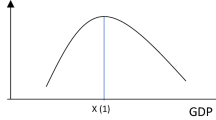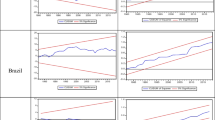Abstract
The pollution haven hypo thesis (PHH) postulates that foreign direct investment (FDI) inflows can increase environmental deterioration in developing countries as multinational firms tend to transfer their dirty industries to these countries. Turkey, as a developing economy, has witnessed intense FDI inflows over the last decades. Within this scope, the goal of this paper is to examine whether the pollution haven hypothesis (PHH) prevails in Turkey within the scope of the environmental Kuznets curve (EKC) hypothesis over the period 1970–2016. To that end, the paper employs unit root and cointegration methods based on the nonlinear smooth transition models. The empirical findings of the paper indicate that both hypotheses are valid in Turkey. The findings also imply that environmental quality in Turkey is negatively related to electricity production from renewable energy sources.


Similar content being viewed by others
References
Acharrya J (2009) FDI, growth and environment; evidence from India on CO2 emission during the last two decades. J Econ Dev 34:43–58
Akbas YE, Senturk M, Sancar C (2013) Testing for causality between the foreign investment, current account deficit, GDP and total credit: Evidence from G7. Panoeconomicus 60:791–812
Akbostanci E, Tunc GI, Turut-Asik S (2007) Pollution haven hypothesis and the role of dirty industries in Turkey's exports. Environ Dev Econ 12:297–322
Anyanwu JC (2006) Promoting investment in Africa. Afr Dev Rev 18:42–71
Apergis N, Payne JE, Menyah K, Wolde-Rufael Y (2010) On the causal dynamics between emissions, nuclear energy, renewable energy, and economic growth. Ecol Econ 69:2255–2260
Arisoy I (2012) The impact of foreign direct investment on total factor productivity and economic growth in Turkey. J Dev Areas 46:17–29
Baek J (2016) A new look at the FDI-income-energy-environment nexus: dynamic panel data analysis of ASEAN. Energy Policy 91:22–27
Bagliani M, Bravo G, Dalmazzone S (2008) A consumption-based approach to environmental Kuznets curves using the ecological footprint indicator. Ecol Econ 65:650–661
Bilgili F, Ozturk I, Kocak E, Bulut U, Pamuk Y, Mugaloglu E, Baglitas HH (2016) The influence of biomass energy consumption on CO2 emissions: a wavelet coherence approach. Environ Sci Pollut Res 23:19043–19061
Broock WA, Scheinkman JA, Dechert WD, LeBaron B (1996) A test for independence based on the correlation dimension. Econ Rev 15:197–235
Bulut U (2019) Testing environmental Kuznets curve for the USA under a regime shift: the role of renewable energy. Environ Sci Pollut Res 26:14562–14569
Bulut U (2020) Environmental sustainability in Turkey: an environmental Kuznets curve estimation for ecological footprint. Int J Sustain Dev World Ecol. https://doi.org/10.1080/13504509.2020.1793425
Bulut U, Inglesi-Lotz R (2019) Which type of energy drove industrial growth in the US from 2000 to 2018? Energy Rep 5:425–430
Bulut U, Muratoglu G (2018) Renewable energy in Turkey: great potential, low but increasing utilization and an empirical analysis on renewable energy-growth nexus. Energy Policy 123:240–250
Chiu CL, Chang TH (2009) What proportion of renewable energy supplies is needed to initially mitigate CO2 emissions in OECD member countries? Renew Sust Energ Rev 13:1669–1674
Copeland BR, Taylor MS (2003) Trade and environment: theory and evidence. Princeton University Press, New Jersey
Coskun AA, Turker O (2011) Analysis of environmental impact assessment (EIA) system in Turkey. Environ Monit Assess 175:213–226
Destek MA, Okumus I (2019) Does pollution haven hypothesis hold in newly industrialized countries? Evidence from ecological footprint. Environ Sci Pollut Res 26:23689–23695
Dinda S (2004) Environmental Kuznets Curve hypothesis: a survey. Ecol Econ 49:431–455
Dong K, Hochman G, Zhang Y, Sun R, Li H, Liao H (2018) CO2 emissions, economic and population growth, and renewable energy: empirical evidence across regions. Energy Econ 75:180–192
Elvan OD (2018) Analysis of environmental impact assessment practices and legislation in Turkey. Environ Sci Pol 84:1–6
Enders W (2015) Applied econometric time series, fourth edn. Wiley, Hoboken
Engle RF, Granger CW (1987) Co-integration and error correction: representation, estimation, and testing. Econometrica 55:251–276
Ercakar ME, Guvenoglu H (2018) The effect of foreign direct investment on the unemployment: the application of Turkey (1980-2016). J Soc Sci Mus Alparslan Univ 6:349–356
Eryigit M (2012) The long run relationship between foreign direct investment, export and gross domestic product: panel data implications. Theor Appl Econ 10:71–82
Gocer I, Mercan M, Peker O (2013) Export, foreign direct investment and unemployment: the case of Turkey. Bus Econ Res J 4:103–120
Gokmenoglu K, Taspinar N (2016) The relationship between CO2 emissions, energy consumption, economic growth and FDI: the case of Turkey. J Int Trade Econ Dev 25:706–723
Graham EM, Krugman P (1993) The surge in foreign direct investment in the 1980s. In: Froot K (ed) Foreign direct investment. University of Chicago Press, Chicago, pp 113–136
Grossman GM, Krueger AB (1991) Environmental impacts of a North American free trade agreement. NBER Work Pap 3914
Grossman GM, Krueger AB (1995) Economic growth and the environment. Q J Econ 110:353–377
Gunaydin I, Tatoglu E (2005) Does foreign direct investment promote economic growth? Evidence from Turkey. Multinatl Bus Rev 13:89–106
Gunsen I (2015) Automotive industry: economic effects of foreign direct investment in Turkey. Uludag J Econ Soc 34:19–34
IEA (2009) World Energy Outlook. https://www.iea.org/reports/world-energy-outlook-2009. Accessed 24 February 2021
IEA (2021) Data and statistics. https://www.iea.org/data-and-statistics?country=WORLD&fuel=Energy supply&indicator=TPESbySource. Accessed 23 February 2021
Jager-Waldau A (2007) Photovoltaics and renewable energies in Europe. Renew Sust Energ Rev 11:1414–1437
Jalil A, Feridun M (2011) The impact of growth, energy and financial development on the environment in China: a cointegration analysis. Energy Econ 33:284–291
Johansen S (1995) Likelihood based inference in cointegrated vector autoregressive models. Oxford University Press, Oxford
Kapetanios G, Shin Y, Snell A (2003) Testing for a unit root in the nonlinear STAR framework. J Econ 112:359–379
Kapetanios G, Shin Y, Snell A (2006) Testing for cointegration in nonlinear smooth transition error correction models. Econ Theory 22:279–303
Karimov M, Paradi-Dolgos A, Pavlin RK (2020) An empirical analysis of the relationship between foreign direct investment and unemployment rate: evidence from Turkey. Eur Res Stud J 23:453–464
Kocak E, Sarkgunesi A (2018) The impact of foreign direct investment on CO2 emissions in Turkey: new evidence from cointegration and bootstrap causality analysis. Environ Sci Pollut Res 25:790–804
Kuznets S (1955) Economic growth and income inequality. Am Econ Rev 45:1–28
Lewis JI, Wiser RH (2007) Fostering a renewable energy technology industry: An international comparison of wind industry policy support mechanisms. Energy Policy 35:1844–1857
Li P, Ouyang Y, Zhang L (2020) The nonlinear impact of renewable energy on CO2 emissions: empirical evidence across regions in China. Appl Econ Lett 27:1150–1155
Mert M, Boluk G (2016) Do foreign direct investment and renewable energy consumption affect the CO2 emissions? New evidence from a panel ARDL approach to Kyoto Annex countries. Environ Sci Pollut Res 23:21669–21681
Mert M, Caglar AE (2020) Testing pollution haven and pollution halo hypotheses for Turkey: a new perspective. Environ Sci Pollut Res 27:32933–32943
Mutafoglu TH (2012) Foreign direct investment, pollution, and economic growth: evidence from Turkey. J Dev Soc 28:291–297
Nemet GF, Kammen DM (2007) US energy research and development: declining investment, increasing need, and the feasibility of expansion. Energy Policy 35:746–755
Ozturk I, Kalyoncu H (2007) Foreign direct investment and growth: an empirical investigation based on cross-country comparison. Econ Internazionale 60:75–82
Panwar NL, Kaushik SC, Kothari S (2011) Role of renewable energy sources in environmental protection: a review. Renew Sust Energ Rev 15:1513–1524
Pata UK (2018) The influence of coal and noncarbohydrate energy consumption on CO2 emissions: revisiting the environmental Kuznets curve hypothesis for Turkey. Energy 160:1115–1123
Republic of Turkey Ministry of Energy and Natural Resources (2014) National renewable energy action plan for Turkey. https://www.ebrd.com/news/2015/ebrd-supports-turkeys-shift-to-renewable-energy.html. Accessed 24 November 2020
Sarkodie SA, Strezov V (2019a) Effect of foreign direct investments, economic development and energy consumption on greenhouse gas emissions in developing countries. Sci Total Environ 646:862–871
Sarkodie SA, Strezov V (2019b) A review on Environmental Kuznets curve hypothesis using bibliometric and meta-analysis. Sci Total Environ 649:128–145
Seker F, Ertugrul HM, Cetin M (2015) The impact of foreign direct investment on environmental quality: a bounds testing and causality analysis for Turkey. Renew Sust Energ Rev 52:347–356
Shahbaz M, Nasreen S, Abbas F, Anis O (2015) Does foreign direct investment impede environmental quality in high-, middle-, and low-income countries? Energy Econ 51:275–287
Sun S, Fang C (2018) Water use trend analysis: A non-parametric method for the environmental Kuznets curve detection. J Clean Prod 172:497–407
Tapsin G (2016) The relationship between foreign direct investment, export and economic growth in Turkey. J Bus Manag Econ 4:1–6
Terasvirta T (1994) Specification, estimation, and evaluation of smooth transition autoregressive models. J Am Stat Assoc 89:208–218
Terzi H, Pata UK (2020) Is the pollution haven hypothesis (PHH) valid for Turkey? Panoeconomicus 67:93–109
Turkish Statistical Institute (2020) Main statistics. http://www.turkstat.gov.tr/UstMenu.do?metod=temelist. Accessed 9 November 2020
Ulucak R, Bilgili F (2018) A reinvestigation of EKC model by ecological footprint measurement for high, middle and low income countries. J Clean Prod 188:144–157
World Bank (1993) Global economic prospects and the developing countries. http://pubdocs.worldbank.org/en/568591462827608813/Global-Economic-Prospects-1993.pdf. Accessed 24 November 2020
World Bank (2020) World Development Indicators (WDI). https://data.worldbank.org. Accessed 9 November 2020
Zhang C, Zhou X (2016) Does foreign direct investment lead to lower CO2 emissions? Evidence from a regional analysis in China. Renew Sust Energ Rev 58:943–951
Availability of data and materials
The data sets used and/or analysed during the current study are available from the corresponding author on reasonable request.
Author information
Authors and Affiliations
Contributions
Umit Bulut: Conceptualization, formal analysis, methodology, project administration, and writing—original draft and review and editing. Gulbahar Ucler: Conceptualization, data curation, investigation, and writing—original draft. Roula Inglesi-Lotz: Supervision, validation, and writing—original draft.
Corresponding author
Ethics declarations
Ethics approval and consent to participate
Not applicable.
Consent for publication
Not applicable.
Competing interests
The authors declare no competing interests.
Additional information
Responsible Editor: Philipp Gariguess
Publisher’s note
Springer Nature remains neutral with regard to jurisdictional claims in published maps and institutional affiliations.
Rights and permissions
About this article
Cite this article
Bulut, U., Ucler, G. & Inglesi-Lotz, R. Does the pollution haven hypothesis prevail in Turkey? Empirical evidence from nonlinear smooth transition models. Environ Sci Pollut Res 28, 38563–38572 (2021). https://doi.org/10.1007/s11356-021-13476-7
Received:
Accepted:
Published:
Issue Date:
DOI: https://doi.org/10.1007/s11356-021-13476-7




